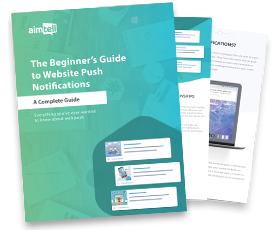Creating a great push notification isn’t just about writing clever copy. To truly stand out and drive results, your push notifications need the right mix of engaging content and smart delivery tactics. That means building personalized, relevant messages and ensuring those messages reach the right audience at the right time.
To help you out, we’ve gathered what we consider to be the four key elements that go into building the best push notifications, two focused on the notification content itself and two that are all about optimizing delivery. Let’s get into it!
Push Notification Features
1. Custom Attributes: Add Personalization That Converts
Generic messages don’t cut it anymore. Today’s users expect content that feels personalized and relevant to them. That’s where custom attributes come in. These attributes allow you to insert subscriber-specific information into your web push notifications, such as their name, total spend, time since last login, preferred category or any other data point you choose to track.
You can also use built-in generic variables (like device type) right away. These details help your push notifications feel less like a mass blast and more like a one-to-one conversation, which can help boost engagement.
According to recent data, 71% of consumers expect personalized communications from brands. If your notifications feel too generic, there’s a good chance your audience will tune them out. Custom attributes help ensure that each push feels more tailored, relevant and engaging.
2. Emojis: Small Detail, Big Impact
Emojis may seem like a small thing, but they consistently make a big difference. Adding emojis to your notification titles, body text or action buttons can help your messages visually stand out, especially when space is limited. Emojis offer a visual shorthand that draws the eye and communicates emotion or intent quickly.
They’re also a great tool for saving space. With push notifications offering limited character count, an emoji can often say more than a few words. Want to test their impact? Try running an A/B test with and without emojis to see how your audience responds.
Delivery Features: Reach The Right Audience
3. Segmentation: Target Messages That Resonate
Even the best-crafted push notification will fall flat if it’s sent to the wrong people. Segmentation helps you send messages to specific groups, ensuring your notifications are timely and relevant. Whether you’re promoting a flash sale or sharing new content, segments help you get the right message to the right audience.
Common segmentation options include:
- Ecommerce: Repeat buyers, cart abandoners, product category interests
- Publishers: Readers of specific article topics, frequency of site visits
- Travel: Users who searched flights to a certain destination, last trip date
- Tech: Free trial users, feature usage, platform type
Building logical audience groupings based on your industry will ensure your messaging resonates.
4. Triggered Notifications: Automate Based On Behavior
Triggered notifications take personalization a step further. Instead of manually sending to a segment, triggered notifications automatically send based on individual behavior, like viewing a specific product, adding an item to a cart, completing a form or visiting a specific page.
These notifications feel hyper-relevant because they’re tied directly to a user’s activity. You can also enhance them with custom attributes and emojis to make them even more engaging.
For Shopify and WooCommerce users, many custom events are already set up out of the box, making it easy to start using triggers right away. If not, setting up custom events is easy and gives you endless possibilities to engage your audience based on their behavior.
Wrapping Up
Building the best push notification isn’t just about what you say; it’s also about who you send it to and when. By combining thoughtful content (like emojis and personalization) with smart delivery strategies (like segmentation and triggered sends), you can maximize engagement and drive better results.
Not using Aimtell yet? Start your free trial or book a personalized demo to discover how our platform can help you build powerful web push campaigns that convert.
For more updates, insights and tips, visit our blog or explore our guides collection.
GET STARTED FREE
Tags:
aimtell, digital marketing, web push notifications.

























